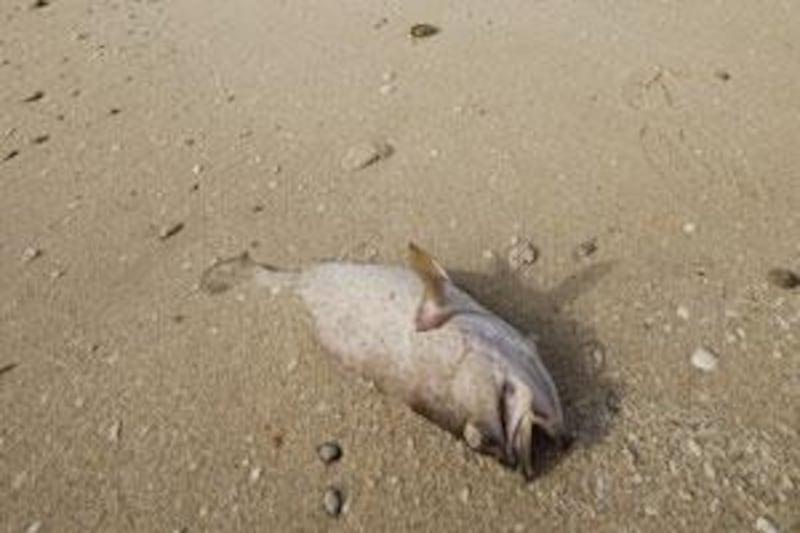The stench from Dubai Creek was unmistakable, and its cause familiar and instantly apparent: tonnes of dead fish, floating in the water and washing up on the shores. And yet, the reason for the mass deaths remains officially obscure, the subject of a delayed report. By itself, the event is not unusual - it often happens around this time of year, the result of depleted oxygen levels in the water, sapped by algae that build up with the wrong combination of high water temperatures and chemical outflows into the Creek.
What is not so clear is the reason the phenomenon appears to be so much more extreme than in previous years. Usually, a few tonnes of dead fish wash up; this year, there have been reports of more than 100 tonnes being dumped in Dubai landfills since late September. Environmentalists claim they had never encountered the problem on such a scale. An official report has been compiled by Dubai Municipality and was due for release yesterday. But the release was postponed at the last minute, apparently for review by high-ranking members of the Dubai Government.
It could now be released by tomorrow, a spokesperson said yesterday they were unable to comment. Yesterday, the beach stretching from Al Garhoud Bridge to Business Bay was strewn with fish, some still alive but paralysed and gasping for air. Hundreds more lay on their sides in the waters of the creek itself. Most had begun to bloat as they started to decay, emitting a pungent smell. Rama Swarmi, 33, from India, is a safety assistant at Dubai Festival City's storm water station, situated next to Business Bay bridge, where about a hundred fish have been trapped in a sluice gate. He first noticed fish being washed ashore on Thursday.
"Most of the fish are about the size of a hand and they appear to have been paralysed," he said. "The smell for the last few days has been terrible and made it difficult for my team to work." Dr Ulrich Wernery, the scientific director of the Central Veterinary Research Laboratory (CVRL) in Dubai, said that while such events do happen regularly in the Creek during summer, the magnitude of this event appeared to be much larger.
"Over the past few years, there are also some fish dying each year," said Dr Wernery. "It used to happen more or less once a year, and always in summer when the water temperature was high." Previous samples by CVRL had usually blamed high water temperatures and low levels of dissolved oxygen for causing suffocation and bacterial infections on the fishes' gills. "You have to face this phenomenon in any stagnant body of water during summer," said Dr Wernery.
However, he said the laboratory's previous work had investigated deaths of only several tonnes of fish on each occasion. He could not explain the difference in scale, nor say what could have caused this year's event, as CVRL has this time not received fish samples from the municipality. Previously, experts have pointed to outflow from the Al Aweer sewage treatment plant. The issue was discussed publicly last year in Dubai at the International Conference on Coastal and Port Engineering. Then, several experts pointed to the nutrient-rich outflow of the sewage plant as the main reason why the Creek water was low in oxygen.
The water is treated so that the organic load and most harmful bacteria are removed. However it has very high concentrations of nutrients such as phosphorus and nitrate, which at 22mg per litre, is several times the recommended safe norm. The nutrients allow algae to grow quickly, a problem exacerbated by the length of the Creek which makes it difficult to flush out the water in its upper part, where the sewage plant discharge is released.
The quality of the outflow has suffered, particularly in the last two years as sewage loads arriving at the plant have reached twice its design capacity. Dr John Burt, a marine biologist with New York University-Abu Dhabi, explained how nutrient-rich outflow from the sewage treatment plant could be affecting animals in the Creek. "An algal bloom associated with the high nutrient loads recently reported for the Deira creek could be one possible mechanism to explain the recent spike in fish mortality," he said.
"Increased algal growth is a common response to heavy nutrient loads in the marine system, which could result in fish deaths either through direct toxicity or by lowering the amount of dissolved oxygen in the water column." A number of species of algae do produce toxins that can have quite negative ecological consequences at high concentrations, including fish mortalities, said Dr Burt. "However, this is generally species-specific, and as far as I am aware there have been no reports of toxic algal species in the creek," he said. "More plausibly, the fish deaths may have resulted from low oxygen conditions brought on by high nutrient loads and warm water temperatures."
Warm, nutrient-rich water would be favourable for growth of algae and bacteria, he said. This, in turn, could lead to increased oxygen demand, lowering the amount of oxygen in the water available for fish. Such conditions have been associated with mass fish-mortalities in other areas, including that of Fujairah during the red tide last year. "However, this is purely speculative at this point, as there are a number of other possible factors that may have led to this particular event in the creek," he said.
"Dubai Municipality regularly collects water quality data in the creek, and are likely exploring all of these possibilities before making definitive public statements. "This is a sensitive issue, and the municipality will be working behind the scenes to find a rapid solution for this problem." vtodorova@thenational.ae tbrooks@thenational.ae






